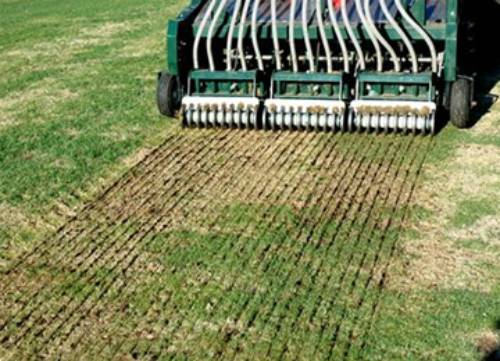Do I Need To Seed My Lawn?
Late summer is the best time to decide what, if any, seeding needs to be done to your lawn. Careful and advanced planning is needed for a successful seeding. Here a few reasons you need to seed your lawn.
Thin Lawn
If you can see the soil in your lawn it is time to seed. These spots are an opening for weeds, disease, and insects. It also causes the lawn to dry out much faster. A thin lawn, or one with several bare spots requires an over seeding.
Heavy Thatch
The thatch layer can become so heavy that the primary root system of your lawn is growing more in the thatch than in the soil below. Shallow, thatch-rooted lawns are susceptible to drought damage. Problems with thatch layers can include, storage for disease, preventing air, water, and nutrients from reaching the roots, and it is an ideal home for insects. To prevent these problems dethatch your lawn if the thatch layer is over 1/2″ thick. After dethatching you will want to consider aeration. If thatch is an issue, more than likely compaction is also an issue. Aeration will loosen up the soil and relieve any compaction. Slit seeding or over seeding can be done after aeration.
Rejuvenate An Old Lawn
Many older lawns were planted with common type turf grasses not suited for the needs of today’s homeowners. newer turf grass varieties are more resistant to insects, disease, drought, shady locations, and heavy traffic.
Why Is Fall Seeding The Best?
- Seed planted in the fall has two growing periods (fall and spring) to germinate and grow before going through the drought and heat stress in the summer.
- In the fall, most fast growing weeds like crabgrass will not be sprouting and attacking the growing grass.
- Soil temperatures are higher in late summer, which means faster germination and establishment of grass.
- Late seasons seeding will not disrupt the proper timing of weed control like spring seeding does. Newly planted grass should not be treated for weeds until it is established.
What Is The Best Way To Plant Seed?
With overseeding, the seed is broadcast evenly over the lawn and is washed into the soil where it lodges and sprouts. Another method is aeration plus overseeding. The main advantage of this method is that aeration opens the soil and provides a better germinating area by improving seed to soil contact. For badly damaged or very thin and thatch lawns, slit seeding is an excellent way to get your lawn back on the road to health and beauty. Slit seeding plants the seed into the soil while destroying thatch. When properly overseeded, a thin lawn can be turned into a thick, lush lawn in just a few weeks!
What To Do After The Seed Is Planted
- Water, water, water! Deep but infrequent watering is the best method. At least 1″ of water per week is recommended.
- Approximately 4-6 weeks after germination, fertilize the lawn normally.
- Protect your lawn from foot traffic until established.
- Wait to mow until the new seedlings reach a height of 4-5″.

This design is steller! You obviously know how to keep a reader amused. Clarie Gaspard Laurette
I have been checking out a few of your articles and i must say clever stuff. I will surely bookmark your site. Darbie Wake Barnum
I conceive other website owners should take this internet site as an example , very clean and good user friendly layout. Astrix Roy Hatti
I need to say your site is really helpful I also love the theme, its amazing! Martguerita Henderson Tennies
Appreciating the time and effort you put into your site and in depth information you present. It’s great to come across a blog every once in a while that isn’t the same outdated rehashed information. Wonderful read! I’ve saved your site and I’m adding your RSS feeds to my Google account.
Very efficiently written post. It will be beneficial to everyone who employess it, including myself. Keep doing what you are doing – i will definitely read more posts.